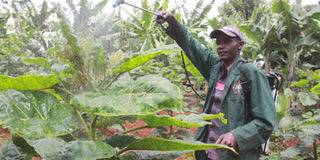Ask your Agronomist: Understanding foliar fertiliser and how to use it effectively

A farmer sprays foliar on crops. This technique of applying liquid fertiliser directly to plant leaves to boost growth and production is effective and the efficiency with which the foliar-applied nutrients can be taken up and utilised by the crop will depend on the relative mobility of the particular nutrient. FILE PHOTO | JOSEPH KANYI | NMG
What you need to know:
- The efficiency with which the foliar-applied nutrients can be taken up and utilised by the crop will depend on the relative mobility of the particular nutrient.
- In tomatoes for example, applying calcium as foliar may still result in incidences of blossom end rot despite having supplied the required calcium.
- These nutrients must be supplied principally through the soil or other media for root uptake.
- For effective use of the foliar products, use spreaders and stickers to ensure even application on the leaves and prevent the product from easily washing off the leaf surface.
Q : Please explain the use of foliar fertilisers. Besides, can I use only foliar fertiliser instead of the solid/granular ones.
Ann
Foliar fertilisers are indeed extensively used to supply plants with nutrients the world over.
In general, plants have the capacity to take up nutrients either through the leaf tissue or through the plant roots by diffusion, osmosis or interception by plant roots.
The principle route to use to supply the nutrients will depend largely on the relative amounts of the nutrients needed by the crop.
The efficiency with which the foliar-applied nutrients can be taken up and utilised by the crop will depend on the relative mobility of the particular nutrient.
The movement of these nutrients is mainly through the plants’ phloem tissue, from which the nutrients are conveyed to the sites where they are needed for optimum plant or cellular function.
So, for nutrients that are mobile within the plant, such as nitrogen and potassium, a foliar application would be okay in delivering them to the various plant parts.
However, for nutrients such as calcium, sulphur or iron that are very immobile in the plant, a foliar application will not be effective in delivering them to where they are most required.
In tomatoes for example, applying calcium as foliar may still result in incidences of blossom end rot despite having supplied the required calcium.
This is because the calcium will tend to be concentrated in the leaves and does not move into the fruits where it’s required to prevent blossom end rot.
Besides nutrient mobility, the most important consideration should be the amounts of the nutrients required by the crop.
The major plant nutrients – N, P, K – as well as the secondary nutrients Ca, Mg and S, are required in relatively large amounts by crops, such that a foliar route would not supply the needed amounts.
These nutrients must be supplied principally through the soil or other media for root uptake.
Micro-nutrients, on the other hand, including Zn, Cu, Fe and Mn are critical for plant production, but required in relatively low amounts.
These can, therefore, be efficiently applied through foliar fertilisers.
Hidden hunger: It is important to note that plants may suffer from certain nutrient deficiencies even though this may not physically be manifested yet.
This is especially so for the micro-nutrients and this already begins to compromise yields.
For this reason, it’s recommended to apply the micro-nutrients as a foliar and prevent full-blown deficiencies.
For effective use of the foliar products, use spreaders and stickers to ensure even application on the leaves and prevent the product from easily washing off the leaf surface.
For crop specific fertiliser recommendations, please consult the following agronomists in your area:
Central Region: Stephen Mburu, 0728396204.
Upper Rift Valley: Daniel Mui 0702466343.
Eastern: Dennis Nyandaya, 0702466372.
Lower Rift Valley: Chris Masira, 0798498320.
Western: Eric Okwado, 0715484224.
Vitalis wafula, East Africa Regional Agronomist Yara.




